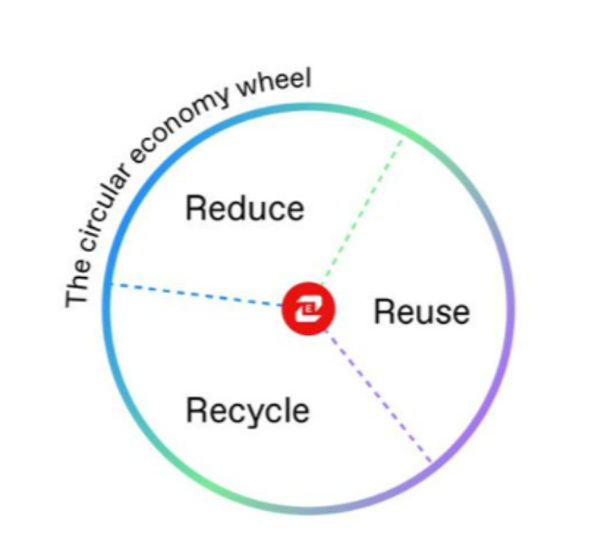- Elkem
- Sustainability
- The circular economy
The circular economy

With a mission to provide advanced material solutions shaping a better and more sustainable future, Elkem aspires to be a part of the answer to battle climate change. Last year, Elkem released its climate roadmap, outlining how the company plans to cut emissions to net zero while increasing supply for the green transition. In order to reach the goal of reducing emissions, we need to empower and create Circular Economies. But what does it mean exactly?
The circular economy – definition
The circular economy entails creating goods and services in a sustainable manner, while reducing excessive resource use and waste creation. It is about transitioning from a throwaway culture to a more circular one. We usually take resources from the Earth, manufacture products from these resources, and then toss them away as garbage in our existing system - the process is linear. In a circular economy, on the other hand, we prevent waste from being created in the first place. This involves employing processes that repair, replenish, or revitalize their own energy and materials while wasting as little as possible.
Moving toward circularity necessitates the development of new materials and products, as well as new technologies and manufacturing techniques. The transition to circularity includes using less material to achieve the same or better usefulness from products. However, it is not only about materials; new business and governance structures are also crucial.
At Elkem, the objective is to increase circularity
Elkem is focused on circularity and has adopted a 3R approach within the organisation, which stands for Reduce (our environmental impact), Reuse (our repurpose products that are still fit for use) and Recycle (our waste and the end-of-life of our products are turned into raw materials for new products). Three examples illustrating Elkem' 3R approach will be explained below.
Reduce: energy recovery for hospitals
Large smelting furnaces, which demand a lot of electricity, are used for silicon production. The high temperature of the exhaust gases from the facilities' silicon furnaces may be utilised to recover electric power. On top of repurposing energy, the technique also helps to reduce plant emissions. Earlier last year, Elkem and Salten Energigjenvinning came to an agreement with Sykehusinnkjp HF, one of Norway's largest buying organizations on behalf of three regional health trusts. From now on, Helse nord, Helse vest, and Helse Midt-Norge hospitals will utilise electrical energy generated by Norwegian industry. Energy recovery facilities at the plants Elkem Salten, Elkem Thamshavn, and Elkem Bjølvefossen in the counties of Nordland, Trndelag, and Vestland provide electrical power for the hospitals. This is a great example of the Circular Economy in which excess energy is not wasted.
Recycle: of wooden pallets in India
Elkem India, including the Nagpur factory, uses a total of 6.000 pallets per year, the most (if not all) of which are now recycled pallets. The Nagpur team came up with the concept to re-use inbound pallets whenever possible and repair those that aren't in commercial good shape to avoid buying new ones as part of the employee suggestion program DISHA.
Pallets that have been damaged are collected and transferred to an outside repair business. The carpenter is repairing these pallets so that they can be used both within the facility and externally. After a successful pilot shipment to China in June 2018 with repaired pallets, a larger project was launched. Pallet repair is now done using an internal setup. Following this first success, all warehouses have begun reusing inbound pallets, resulting in additional waste reduction. Thanks to this initiative embracing the Circular Economy, Elkem India reuses 6.000 pallets each year.
Reuse: BRIQSIL™ as a substitute for ferrosilicon
Briquetting is an example of better reuse by Elkem. BRIQSIL™ is a ferrosilicon substitute that can be used to generate heat during steel making so even more scrap can be recycled. Ferrosilicon is friable, and the crushing process results in large volumes of fine materials that have the same chemistry as sized materials, but cannot be recycled or used directly in the process. New methods for making solid briquettes from fines have allowed the material to be fed back into the furnaces, increasing production. The briquettes are tough enough to withstand handling and transportation and they don't fracture or break down when fed into the furnace, transforming fines into high-quality raw materials for recycling or products designed for steel customers.
Elkem is taking action to enable circular economies and thus produce less waste and emissions. The above-mentioned measures that have been taken are merely examples of a larger framework that is aimed at reducing environmental damage. Click here if you want to learn more about sustainability at Elkem.

MORE ABOUT SUSTAINABILITY AT ELKEM
Contact us
Take your business to the next level by partnering with a world-leading material manufacturer.